Photographs of the Mind
Blind folks taking photographs? It may seem unbelievable, but members of the Seeing With Photography Collective have been making pictures for close to 20 years. The collective is a group of photographers with sight ranging from total blindness to “normal” vision. The photos included in this essay are selected from a group of pictures recently on display in Perugia, Italy at the Perugia Social Photo Festival.
These photographs are the work of three of our original members—Steven Erra, Victorine Floyd Fludd, and myself. My vision, while certainly not great, is fully correctable with a pair of glasses. Steve has retinitis pigmentosa, a condition which has gradually destroyed his retina from the outside in, and Victorine lost all of her vision around 35 years ago, when, in a short span of time, she went from fully sighted to complete blindness.
I am the director of the Collective. I began teaching classes in photography to blind students in 1986. After about 10 years of teaching classes, I decided that it was time to get serious about the kind of photography possible for people with various levels of sight. We began to take a journey through photography and explore what sight means to us and to those of us who had lost some, but not all, of the ways that we see. Our journey began with a new way to make pictures that involve the brain, the body, and all of our senses. Our quest: how do you see when you don’t see with your eyes? How do you convey those visions?
We began with some speed graphic cameras, the type you see in old movies where the large camera sits on a tripod and the photographer covers his head with a black cloth. We used Polaroid instant positive negative film to record our images. This film gave us both a good negative to be used to make high quality prints and a lower-quality 4×5” print that immediately provided a means to describe the artwork to the blind photographers who made it.
We used two other essential tools for the creation of our photographs. The first was the light switch, and the second was a flashlight. We began making pictures with the room lights switched off and penlights switched on. What would make more intuitive sense for a visually impaired photographer than taking pictures in the dark? These photographs are made by the movements of our bodies as we paint our subjects with hand-held lights.
This method unlocked an ability to use those elements of sight associated with our mind, not just our eyes. Our photographs do not appear as typical photographs do—as frozen moments in time most often created by the photographer’s instinct. Rather, they will appear as dreams, memories, hallucinations, or visions; they appear as the parts of sight that overlay what most of us see with our eyes. Those whose eyes now function poorly or not at all are more aware of this primary structure for making meaning out of visual stimuli.
Though we now use digital cameras, our group still works in the same way. To stay true to our members, the photographs are made in-camera, with Photoshop employed for only minor adjustments. To see more of our members’ work, please visit seeingwithphotography.com and flickr.com/photos/seeingwithphotography.

John Gardner is one of the original members of the SWPC. John has always been an explorer willing to do or try anything— riskier for someone without sight. I had heard of him before I met him. In a photography class with my good friend Karen Johnson, who introduced me to photography by the blind, John was the student who volunteered to climb a tree for a picture. On a trip to Storm King sculpture center, John rolled down one of the large hills on the museum grounds. He takes great pride in his ability to take great pictures in spite of almost total blindness.
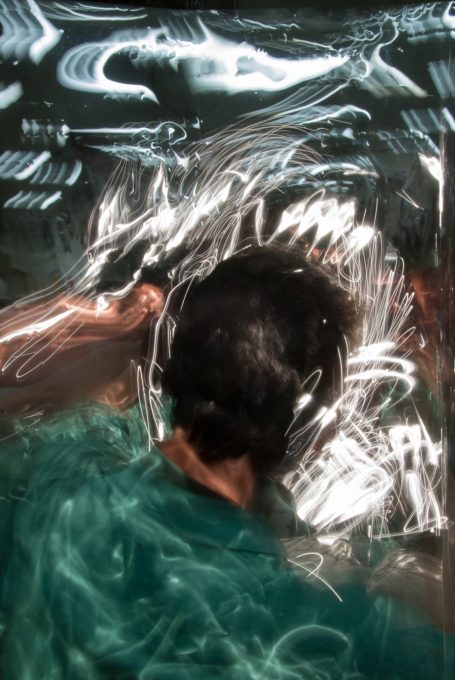
“I’m desperate for light really, any light, any scrap of stray, ineffectual photon, I feel the desperation – my dying retinas ravenous to see, like an emaciated, skeletal dog will gnaw and scour the air off the alley.” –Steven Erra
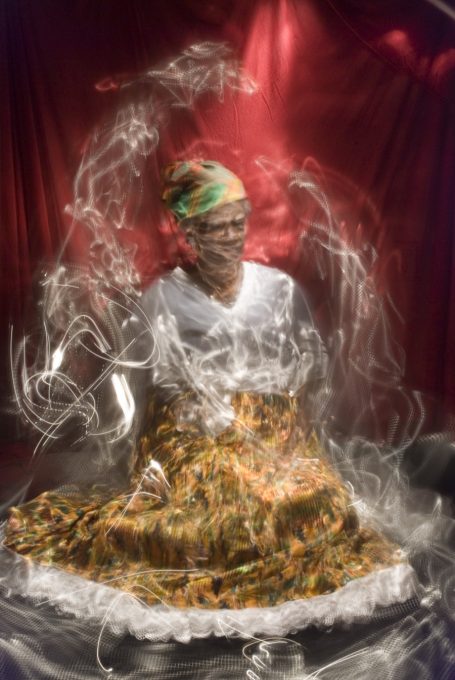
An early self portrait. Vicky has a tremendous sense of space and motion. Often she will dance around the room while we work, never bumping into a thing even amid all the chaos. She is able to incorporate the rhythmic waves of motion of Caribbean song and dance into her photographs, making the lights dance as she does.

Victorine has survived many difficulties in life—not least, having upwards of nine stents placed in her body. I have always liked Mantegna’s portraits of St. Sebastian, and I was thinking of the stents in Vicky’s body as analogous to the arrows piercing the Saint in the Renaissance painter’s work.
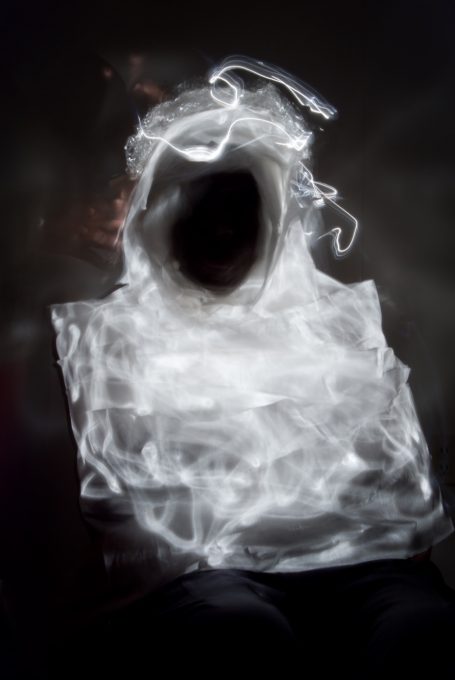
The original Radiant Abyss was a black and white photograph in which the combination of the blackness and glowing light evinced the contradiction of being blind. Stephen Dominguez, one of our original members, came up with the title for this photograph. He has since died, as have many of our members over the years. Often, blindness is accompanied by other physical impairments or illnesses and increased poverty, which correlates to less access to quality health care and healthy living conditions.
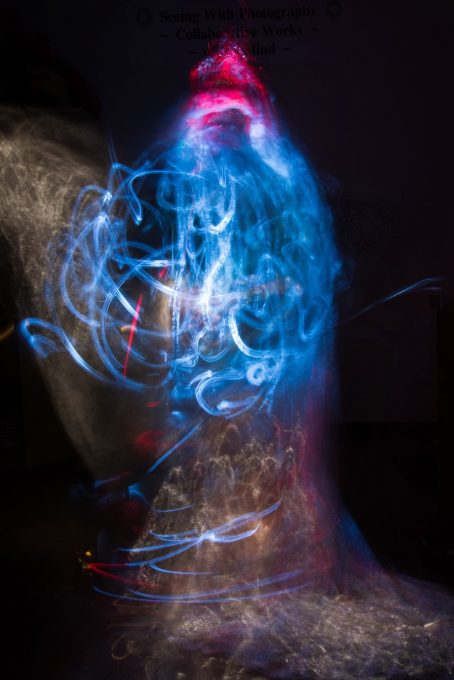
Multiple flashlights enable Vicki to dissolve her body into a radiant luminescence as bright and shining as the stories she tells about her childhood in Antigua.
“How does the blind photographer know what they have made? Those who can see describe, and become the eyes … providing the scope, the tone, and narrative that will form the structure of the new creation, glowing unseen on the camera’s digital screen and glowing too in a different way, in the internal mind of the unseeing artist.” – Steven Erra
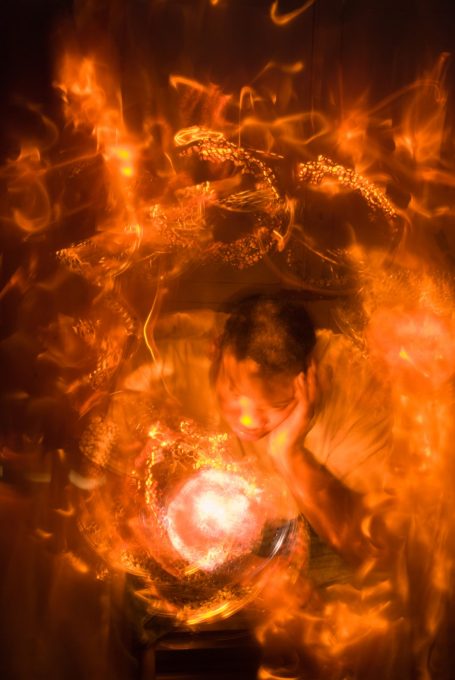
“…Quivering fabrics shaken and moved around fire beings amid Interstellar jewels.” –Steven Erra
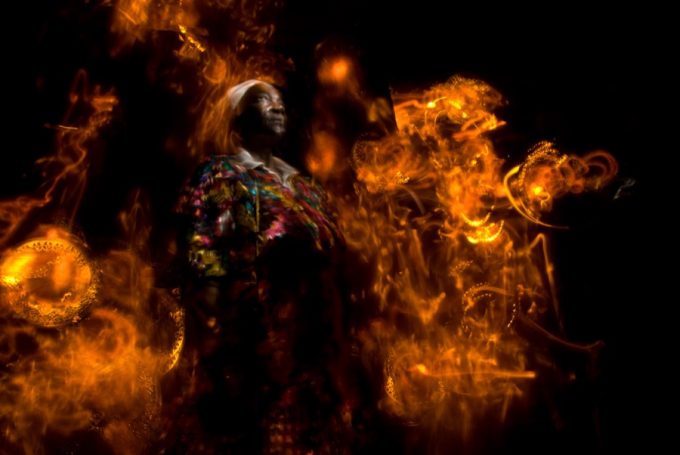
“Something memorable happens creating imagery in the dark, with the dark, the dark as our supportive friend, all of us sighted or blind together, thinking, trying, laughing, describing, listening… weaving something.” – Steve Erra

Vicky came to New York City in an unsuccessful attempt to save her sight. She had a pseudo-tumor that could have been corrected if there had been medical expertise available in Antigua. By the time she received a visa and made arrangements to come to the U… it was too late. Vicky has never seen the city, although she has lived and raised a family here for over 30 years.
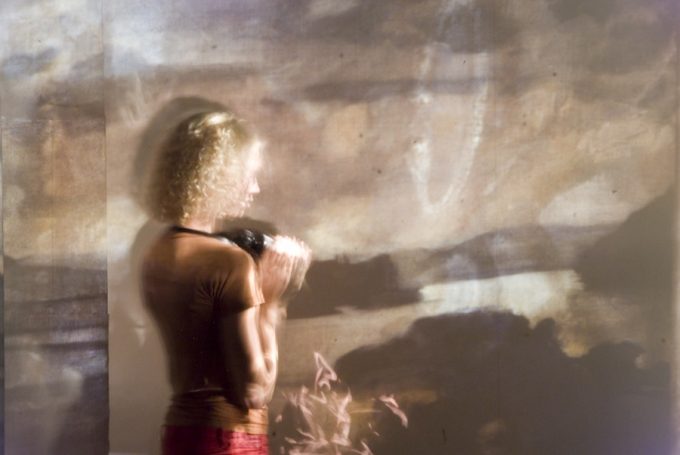
Steve was trained as a painter at Parsons School of Design. His degenerative eye disease brought him to the SWPC, where his early light paintings featured sandwiched slides of his own paintings projected onto his subject. We combined them with figures on which the projection was blocked. My role in this picture was typical of our improvised methods: we built a large dodging tool (darkroom equipment used to block the specific areas of a print), and I laid on the ground, holding it up with a stick (keeping myself and the implement out of the camera’s view).

A cold night on the shore of the Baltic sea in southern Sweden. A small group of us came to southern Sweden to hang an exhibition of our work and give workshops at the museum in Kristianstad. Steve had Mark pose on the stump of a tree wrapped in a sheet. The scene was lit by Steve with help from Victorine. Our group has had shows all over the world including Russia, Venezuela, Puerto Rico, Chile, Canada, Sweden, The Netherlands, Italy, Mexico, and many locations across the United States.
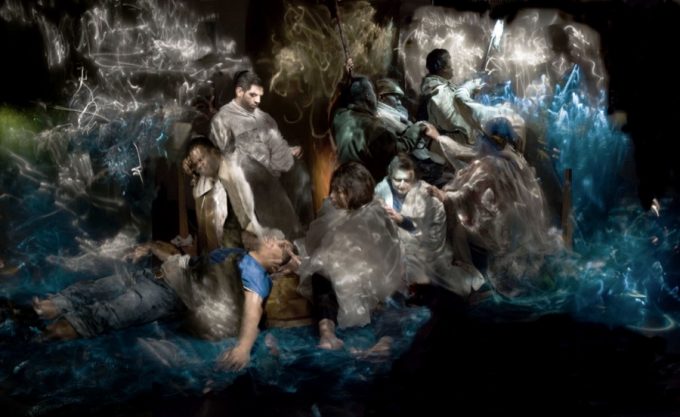
Many of our photographs are collaborations. This photograph was my idea. I posed it and arranged it with input from the group members who lit and posed for the scene. They each contributed their different styles of lighting and work. I based this picture very loosely on Géricault’s The Raft of the Medusa. It was made of three separate pictures stitched together. When we were making the picture, people were talking, giving suggestions, figuring out how to hold the blue tarp to make the water around the raft, laughing and singing, figuring out who would pose where, and joking with each other.
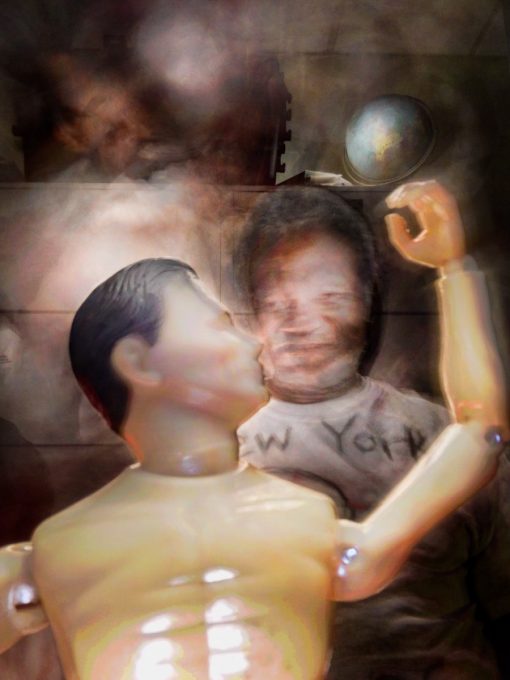
We love the accidental, the flaws that imbue our pictures with the truth of life. The crazed unpredictability of our many techniques gives our photographs a quality akin to the contradictions of life: difficult, beautiful, tragic, loving, mysterious, and vivid.
